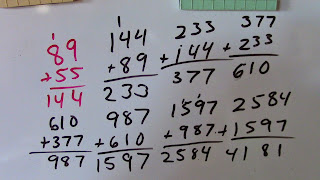Math it has been said many times is a language. Try teaching it that way. Seriously: think about how a child learns English...do they hear the whole language or are we careful only to use small words and short sentences when toddlers are around? I guarantee you'd get bored too if all you did was add and subtract small numbers together for a whole year...and do we wait for kids to be able to write before we teach them English? Why do they have to write before we teach them math concepts...? Base ten blocks will make the whole process easier.

Here we see a shot of a compound lesson, while the student was building addends (using two hands) we talked about Fibonacci a little. The student wasn't familiar with him, and you may not be either, so I made it homework for him to come back and tell me who he was and why he was important to western mathematics.
Also a little conversation on radicals and square roots came up...because of infinite series. The square root of two is a radical because it never ends. We know that the diagonal is finite though, even though if the sides are one, the diagonal has to be the square root of two...and that leads to even more math...

Since we're learning to add why not add numbers from the sequence...?
Here is some fun with Fibonacci:
And you might go to youtube annd search "vihart fibonacci" and watch her three part series. It's fun and playful...the way math should be...and if you like you can doodle along with her...in fact I recommend it.
But WHO was this Fibonacci guy?
He doesn't make an appearance 'till about 40 minutes in, but this is a great way to make the history of math available to students...and teachers, and other adults, and maybe get an inkling of how important Fibonacci was, while we do cool stuff with numbers.
***Very sad that this video got pulled down, probably in the name of copyright. Education takes a backseat to corporate profit yet again. Try this link: https://www.youtube.com/watch?v=4ToUaU4vPks
This is why I like teaching "enrichment" students. We aren't relegated to a textbook that needs to be understood well enough for the obligatory regurgitation that will be required sometime in the near future. Instead we can explore the mathematics and learn things like computation along the way...and of course base ten blocks allow students of all ages to get their hands on the math....in the first video he talks about making rectangles like this.
Building it makes it much more accessible and understandable than just drawing it or using symbols (numerals) to describe it...

When you play with blocks the subconscious mind can get involved in a much more tangible way, because you allow more sensory input than just looking at a drawing or symbols, it becomes visually obvious that the sides of the rectangles as you build them are 2x1 and then 2x3 and then 5x3 and then 5x8 and so on...
Then it's easy to see 5x8 = 2 + 4 + 9 + 25...
And 13x8 = 2 + 4 + 9 + 25 + 64...
For little kids this can be a lot of counting...but you don't already have to have your multiplication or addition memorized you can use this this to help them learn basic operations while seeing a little of the beauty of mathematics along the way....
Don't just watch vids (or read this post), build and count, do some computation, in other words do the math. Use your base ten blocks and have fun.
No comments:
Post a Comment